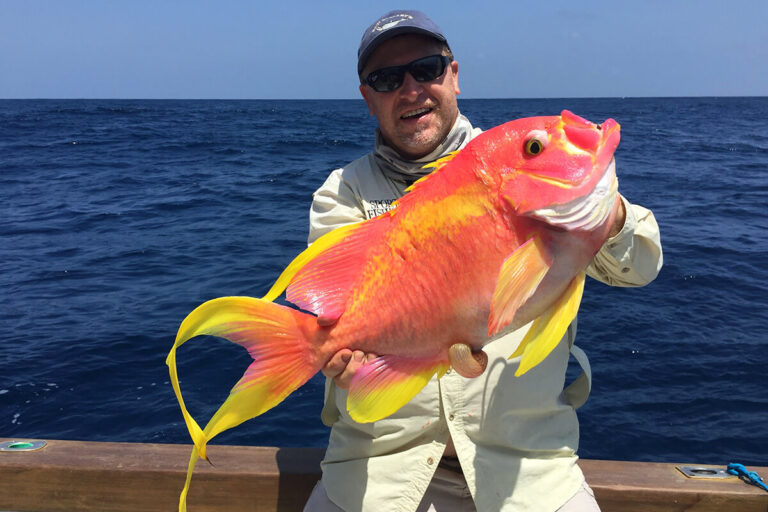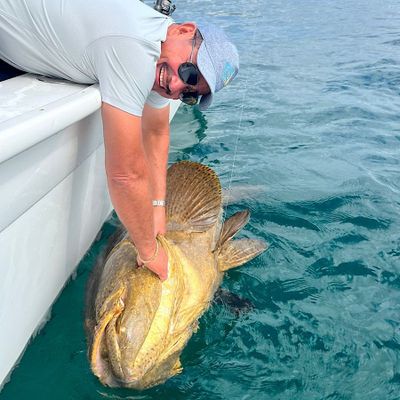To do deep sea fishing, you need to start by gathering the necessary equipment and finding a suitable fishing location. Once you’re ready, cast your line into the deep ocean waters and wait for a bite.

Credit: www.saltwatersportsman.com
Understanding Deep Sea Fishing
Deep sea fishing is an exhilarating experience that allows you to explore the vastness of the ocean and test your angling skills against powerful marine creatures. However, this activity requires careful preparation and a thorough understanding of the deep sea fishing environment.
In this section, we will delve into the importance of equipment and preparation, the process of choosing the right fishing gear, understanding the deep sea fishing environment, and essential safety tips.
Importance Of Equipment And Preparation
Before embarking on a deep sea fishing adventure, it is crucial to adequately prepare yourself and gather the necessary equipment. Here are the key points to consider:
- Research the type of fish you want to catch and the best time of year for that particular species. This knowledge will help you select the appropriate gear and plan your fishing trip accordingly.
- Invest in high-quality fishing equipment, including rods, reels, lines, hooks, and baits. Deep sea fishing requires robust and durable gear to withstand the harsh conditions.
- Prepare all the necessary fishing accessories such as tackle boxes, pliers, fishing nets, and coolers to store your catch.
- Make sure you have the required fishing licenses and permits to avoid legal complications.
- Check the weather conditions and tide charts before setting sail. Unfavorable weather can significantly impact your fishing experience and even pose safety risks.
- Create a checklist of essential items such as sunscreen, hats, sunglasses, snacks, and plenty of water to stay hydrated during the trip.
- Familiarize yourself with the safety measures and emergency protocols for deep sea fishing.
Choosing The Right Fishing Gear
Selecting the right fishing gear is crucial for a successful deep sea fishing excursion. Consider the following points:
- Opt for a sturdy and reliable fishing rod that can handle the weight and resistance of large fish commonly found in deep sea waters.
- Choose a reel with a high line capacity to accommodate the potential length of your line and handle the strength of deep sea fish.
- Select fishing lines and hooks suitable for deep sea fishing, considering their strength, visibility, and resistance to saltwater corrosion.
- Match the bait or lure to the species you are targeting. Different fish have varying preferences, so it is essential to choose the right bait for optimal results.
- Don’t forget to bring along a variety of tackle options to adapt to different fishing conditions and techniques.
Understanding The Deep Sea Fishing Environment
Deep sea fishing takes you far from the shore, and it’s essential to familiarize yourself with the unique environment. Consider the following aspects:
- Deep sea fishing is typically done in waters deeper than 30 meters (100 feet). These areas are home to various fish species, including tuna, marlin, swordfish, and mahi-mahi.
- The underwater topography varies greatly in deep sea locations, with drop-offs, reefs, and underwater structures attracting different species of fish. Research these features beforehand to find productive fishing spots.
- Deep sea fishing takes place in both offshore and nearshore waters, depending on the species you are targeting. Offshore waters offer opportunities to catch larger fish, while nearshore waters are home to a wide range of species.
- Pay attention to temperature changes as different fish species have preferred water temperatures. Use specialized equipment like a fish finder to locate pockets of fish and increase your chances of success.
Safety Tips For Deep Sea Fishing
Deep sea fishing can be a thrilling adventure, but safety should always be a top priority. Here are some important safety tips to keep in mind:
- Always wear a properly fitted life jacket or personal flotation device (pfd) throughout the trip. The ocean can be unpredictable, and a life jacket can save you in case of accidents or emergencies.
- Familiarize yourself with basic first aid techniques and carry a well-stocked first aid kit on board.
- Follow the instructions and guidelines provided by the captain or crew members to ensure a safe and enjoyable fishing experience.
- Be aware of your surroundings, including other fishing boats, rocks, and potential hazards in the water.
- Stay hydrated and protect yourself from the sun by wearing sunscreen, a hat, and sunglasses.
- Listen carefully to the safety briefing before setting sail and know the location of life-saving equipment such as life rafts and emergency exits.
Remember, deep sea fishing offers an extraordinary opportunity to connect with nature and test your fishing skills against formidable ocean dwellers. By understanding the importance of equipment and preparation, choosing the right fishing gear, and following essential safety tips, you can make the most of your deep sea fishing adventure while ensuring a safe and memorable experience.
Mastering Deep Sea Fishing Techniques
Deep sea fishing is an adventurous and thrilling activity that allows you to explore the open waters while testing your angling skills. However, mastering deep sea fishing techniques is essential to ensure a successful and enjoyable experience. In this section, we will cover the key aspects you need to know to become proficient in deep sea fishing.
Learning The Basics Of Casting And Reeling
To effectively catch fish in deep sea waters, understanding the basics of casting and reeling is crucial. Here are the key points to keep in mind:
- Casting technique:
- Hold the fishing rod firmly and maintain a steady grip to generate enough power.
- Position your body sideways with one foot slightly in front of the other for better balance.
- Swing your arm back and then forward in a fluid motion, releasing the line as the rod tip reaches its maximum point.
- Reeling method:
- Use a smooth and consistent motion while reeling in the catch.
- Avoid sudden jerks or tugs that may cause the fish to break free.
- Keep the rod tip up and maintain tension on the line throughout the reeling process.
Using The Proper Bait And Lures
Selecting the right bait and lures is crucial in attracting deep sea fish. Consider the following:
- Natural baits:
- Squid, sardines, and mackerel are popular choices for deep sea fishing.
- Use whole or cut baits to mimic the natural prey of the target fish species.
- Secure the bait to the hook properly to prevent it from falling off easily.
- Artificial lures:
- Jigs, spoons, and swimbaits are effective lures for deep sea fishing.
- Choose lures that resemble the prey of the fish you are targeting.
- Experiment with different colors and sizes to find what works best.
Understanding Different Fishing Techniques
Deep sea fishing offers a variety of techniques that can be employed depending on the conditions and the fish you are targeting. Here are some techniques to consider:
- Trolling:
- Attach one or more lines with lures or baited hooks and slowly drag them behind the moving boat.
- Vary the trolling speed to imitate the movement of prey and attract fish.
- Bottom fishing:
- Drop the baited hook to the ocean floor and wait for fish to bite.
- Use a sinker to keep the baited hook closer to the bottom, where many species congregate.
- Drift fishing:
- Allow the boat to drift with the current while dragging a drifting bait or lure.
- This technique covers a larger area and helps locate active feeding fish.
Targeting Specific Deep Sea Fish Species
Different species of fish inhabit the deep sea, and targeting specific ones requires knowledge about their behavior and preferences. Consider the following species:
- Snapper:
- Commonly found in rocky areas and reefs.
- Use cut bait or live bait near the bottom for best results.
- Tuna:
- Known for their speed and strength.
- Trolling with artificial lures or using live bait on the surface is effective.
- Marlin:
- Highly sought after for their size and fighting ability.
- Use large artificial lures or live bait to entice marlin.
- Mahi-mahi:
- Often found around floating debris or weed lines.
- Use brightly colored lures or live bait near the surface for success.
By mastering deep sea fishing techniques such as casting, reeling, bait selection, and understanding different fishing methods, you will enhance your chances of a successful deep sea fishing expedition. Remember, practice makes perfect, so get out there and enjoy the thrill of deep sea fishing!
Tips For A Successful Deep Sea Fishing Trip
Deep sea fishing is an exhilarating and rewarding activity that offers the opportunity to catch some truly impressive fish in the vast expanse of the ocean. However, without the right knowledge and planning, your deep sea fishing trip may not live up to your expectations.
To ensure a successful and memorable experience, here are some essential tips to keep in mind.
Researching Fishing Hotspots And Best Seasons
It’s crucial to conduct thorough research on fishing hotspots and the best seasons for deep sea fishing. By understanding where the fish are likely to gather and when they are most active, you can significantly increase your chances of a successful outing.
Here are some key points to consider:
- Explore online resources, fishing forums, and local fishing clubs to gather valuable information on popular fishing locations.
- Identify the species of fish you are targeting and research their habitats, migration patterns, and preferred water conditions.
- Pay attention to weather patterns, as different fish species thrive in specific weather conditions.
- Consult with experienced local fishermen or charter companies for insider tips and advice on prime fishing grounds.
Hiring An Experienced Deep Sea Fishing Guide
If you’re new to deep sea fishing or unfamiliar with the area, hiring an experienced fishing guide can make a world of difference. A knowledgeable guide can offer valuable insights, maximize your chances of a successful catch, and ensure a safe and enjoyable trip.
Consider the following points when selecting a fishing guide:
- Look for experienced and licensed guides who have extensive knowledge of the local waters and fish species.
- Read reviews and testimonials to gauge the guide’s reputation and customer satisfaction.
- Inquire about the guide’s equipment, boat condition, and safety measures, as well as their knowledge of navigation and emergency procedures.
- Discuss your fishing goals and preferences in advance to ensure the guide can cater to your needs.
Proper Fishing Etiquette And Conservation Practices
Respecting the ocean and its inhabitants is essential for sustainable fishing and preserving the marine ecosystem. By following proper fishing etiquette and conservation practices, you not only contribute to the health of the ocean but also enhance your fishing experience.
Keep these guidelines in mind:
- Familiarize yourself with local fishing regulations, including size and catch limits, protected species, and restricted areas.
- Practice catch and release whenever possible, especially for vulnerable or endangered species.
- Use barbless hooks to minimize injury to fish and facilitate their release.
- Dispose of any trash responsibly and avoid leaving any items behind, ensuring a clean and litter-free environment.
- Treat other anglers with respect, maintaining a reasonable distance and avoiding interference with their fishing activities.
Staying Patient And Persistent For Big Catches
Deep sea fishing requires patience and persistence, as you may need to wait for long periods before getting a bite. However, with the right mindset and strategies, you increase your chances of reeling in those big catches. Consider the following tips:
- Stay focused and attentive, constantly monitoring your bait and adjusting your techniques as needed.
- Experiment with different types of bait, lures, and fishing techniques to entice various fish species.
- Stay patient, as the ocean is vast, and fish movements can be unpredictable. Trust that your perseverance will pay off.
- Stay positive and enjoy the overall experience, regardless of the size or quantity of your catches.
By following these essential tips, you can ensure a successful deep sea fishing trip and increase your chances of making lasting memories with impressive catches. So, gear up, plan your adventure wisely, and get ready for an exciting expedition into the vast depths of the ocean.
Happy fishing!
Conclusion
Deep sea fishing is an exhilarating and challenging activity that allows you to explore the depths of the ocean. Whether you are a beginner or an experienced angler, following the right steps and techniques can greatly enhance your fishing experience.
By understanding the importance of choosing the right location, using the appropriate equipment, and being mindful of the weather conditions, you can increase your chances of a successful deep sea fishing trip. Moreover, taking the time to learn about different fish species, their behaviors, and feeding habits will give you an advantage when trying to attract them.
Always remember to respect the ocean and its inhabitants, practicing catch and release whenever possible. With the right preparation and knowledge, deep sea fishing can provide you with unforgettable memories and incredible catches. So grab your gear, head out to the open waters, and embark on an adventure that will surely leave you hooked on the thrill of deep sea fishing.






